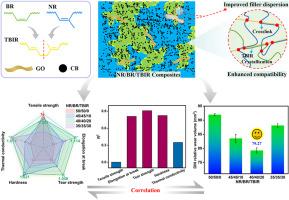Our official English website, www.x-mol.net, welcomes your
feedback! (Note: you will need to create a separate account there.)
Trans-1,4-Poly(isoprene-co-butadiene) Rubber Enhances Abrasion Resistance in Natural Rubber and Polybutadiene Composites
Polymer ( IF 4.1 ) Pub Date : 2024-11-16 , DOI: 10.1016/j.polymer.2024.127855 Jiawei Yang, Feifei Wang, Chaobo Liang, Shaofeng Zhou, Jin Huang, Guizhe Zhao, Yaqing Liu
Polymer ( IF 4.1 ) Pub Date : 2024-11-16 , DOI: 10.1016/j.polymer.2024.127855 Jiawei Yang, Feifei Wang, Chaobo Liang, Shaofeng Zhou, Jin Huang, Guizhe Zhao, Yaqing Liu

|
This study investigates the integration of Trans-1,4-poly(isoprene-co-butadiene) rubber (TBIR) with natural rubber (NR) and cis-1,4-polybutadiene rubber (BR) to enhance the abrasion resistance of rubber composites. The NR/BR blend, a significant material in the rubber industry, is limited by poor interfacial compatibility and non-uniform filler distribution, resulting in heightened abrasion and failure. The addition of TBIR, along with carbon black (CB) and graphene oxide (GO), aims to achieve synergistic reinforcement. The results show that with 20 phr TBIR, the DIN abrasion of the composites decreased by 13.8%, meeting the ISO 10247 standard for high-abrasion conveyor belt cover rubber. The improvement in wear resistance is attributed to TBIR's crystalline nature, which enhances tear strength, hardness, and elongation at break. TBIR also acts as an interface compatibility agent, improving the network structure of the rubber and fillers, thus enhancing composite performance. Observations of Schallamach waves, abrasion surface, and debris morphology indicate that the primary surface abrasion mechanism for the NR/BR/TBIR composites is abrasive abrasion. Regression analysis reveals that the abrasion resistance of the NR/BR/TBIR composites correlates with their mechanical properties and thermal conductivity, with higher tear strength, hardness, and elongation at break correlating with reduced surface damage due to abrasive abrasion. This research provides valuable insights into the development of high-abrasion-resistant natural rubber composites and the investigation of abrasion resistance mechanisms in rubber composites.
中文翻译:

反式 1,4-聚(异戊二烯-共丁二烯)橡胶增强天然橡胶和聚丁二烯复合材料的耐磨性
本研究研究了反式 1,4-聚(异戊二烯-共丁二烯)橡胶 (TBIR) 与天然橡胶 (NR) 和顺式-1,4-聚丁二烯橡胶 (BR) 的结合,以增强橡胶复合材料的耐磨性。NR/BR 共混物是橡胶工业中的重要材料,其界面相容性差和填料分布不均匀,导致磨损加剧和失效。TBIR 的加入,以及炭黑 (CB) 和氧化石墨烯 (GO),旨在实现协同强化。结果表明,在 20 phr TBIR 下,复合材料的 DIN 磨损降低了 13.8%,满足了高磨损输送带覆盖橡胶的 ISO 10247 标准。耐磨性的提高归因于 TBIR 的结晶性质,它提高了撕裂强度、硬度和断裂伸长率。TBIR 还充当界面相容剂,改善橡胶和填料的网络结构,从而提高复合材料性能。对 Schallamach 波、磨损表面和碎片形态的观察表明,NR/BR/TBIR 复合材料的主要表面磨损机制是磨料磨损。回归分析表明,NR/BR/TBIR 复合材料的耐磨性与其机械性能和导热性相关,较高的撕裂强度、硬度和断裂伸长率与磨料磨损引起的表面损伤减少相关。本研究为高耐磨天然橡胶复合材料的开发和橡胶复合材料中耐磨性机理的研究提供了有价值的见解。
更新日期:2024-11-16
中文翻译:

反式 1,4-聚(异戊二烯-共丁二烯)橡胶增强天然橡胶和聚丁二烯复合材料的耐磨性
本研究研究了反式 1,4-聚(异戊二烯-共丁二烯)橡胶 (TBIR) 与天然橡胶 (NR) 和顺式-1,4-聚丁二烯橡胶 (BR) 的结合,以增强橡胶复合材料的耐磨性。NR/BR 共混物是橡胶工业中的重要材料,其界面相容性差和填料分布不均匀,导致磨损加剧和失效。TBIR 的加入,以及炭黑 (CB) 和氧化石墨烯 (GO),旨在实现协同强化。结果表明,在 20 phr TBIR 下,复合材料的 DIN 磨损降低了 13.8%,满足了高磨损输送带覆盖橡胶的 ISO 10247 标准。耐磨性的提高归因于 TBIR 的结晶性质,它提高了撕裂强度、硬度和断裂伸长率。TBIR 还充当界面相容剂,改善橡胶和填料的网络结构,从而提高复合材料性能。对 Schallamach 波、磨损表面和碎片形态的观察表明,NR/BR/TBIR 复合材料的主要表面磨损机制是磨料磨损。回归分析表明,NR/BR/TBIR 复合材料的耐磨性与其机械性能和导热性相关,较高的撕裂强度、硬度和断裂伸长率与磨料磨损引起的表面损伤减少相关。本研究为高耐磨天然橡胶复合材料的开发和橡胶复合材料中耐磨性机理的研究提供了有价值的见解。


















































 京公网安备 11010802027423号
京公网安备 11010802027423号